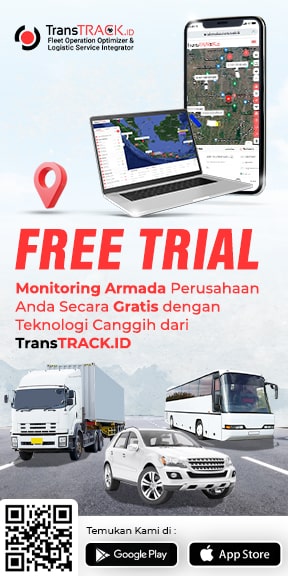Loading Dock: A Special Area to Ensure the Smooth Process of Loading and Unloading Goods
Posted on January 1, 2024 by Nur Wachda Mihmidati

A loading dock is a special area for handling goods in a warehouse, factory or other building. This loading dock is a place where logistics trucks can enter to unload or load goods efficiently. So, in short, loading dock means a place where goods are unloaded from trucks. This area is equipped with special doors and equipment to facilitate the logistics process.
The loading and unloading area is a key element in supply chain management. It becomes the main gateway for the flow of goods in and out. Proper use of these loading bays can save time, optimize the distribution process, and increase the safety of goods. It is important to understand the role and types of loading bays that suit your business needs.
Curious and want to know in more detail what a loading and unloading bay is? Let’s look at the information in this article. Here, TransTRACK will discuss in full about this loading and unloading place, starting from the functions, types, and equipment used.
Loading Dock Function
Loading docks are at the heart of logistics operations at facilities such as warehouses, factories, or distribution centers. The functions of a loading dock are complex and have a major impact on the efficiency and speed of goods flow in the supply chain. Some of its key functions are:
Efficient Loading and Unloading Station
The main function of these loading bays is to facilitate the loading and unloading of goods from and onto transport trucks. Strategically positioned and height-adjusted, these loading bays allow goods to be moved quickly and efficiently between vehicles and storage facilities.
Truck Accessibility
The loading bays are designed to provide optimal accessibility to transport trucks. With the appropriate height and width, trucks can easily intersect with these loading bays, allowing loading and unloading to be carried out quickly and smoothly. This reduces truck waiting time and increases productivity.
Safety of Goods
The safety of goods during the loading and unloading process is the main focus of the loading and unloading function. These facilities are often equipped with lockable warehouse doors to protect goods from theft or damage during the distribution process. Some of these loading and unloading areas are also equipped with additional security systems, such as surveillance cameras and extra lighting.
Protection from Weather and External Environment
Loading and unloading areas are often equipped with shelters or seals that serve to protect the loading and unloading area from bad weather. This not only involves protection against rain and heat, but also provides a more comfortable working environment for employees involved in the loading and unloading process.
Types of Loading Dock
These types of loading docks play a special role in ensuring the efficiency of the loading and unloading process. Here is a complete discussion of the four main types of loading docks that are commonly used:
Flush Loading Dock
Flush loading dock is a design that creates continuity between the floor where goods are unloaded and the truck area. In this configuration, there is no height difference between the warehouse floor and the trucks, creating a smooth and direct flow. The main advantage of a flush loading dock is the ease of truck access and agility in loading and unloading.
However, it should be noted that flush loading docks can complicate the loading and unloading process if the trucks are not on the same level. Therefore, careful selection of truck types and planning are important factors in the implementation of flush loading docks.
Open Loading Dock
Open loading dock is a type that is not equipped with surrounding walls. This design provides open access to the loading dock area, allowing free airflow and the availability of natural light. “Open” loading bays are typically chosen in environments where protection from extreme weather is not a primary need.
While open loading docks provide maximum freedom of access, keep in mind that the lack of protective walls can increase the risk to weather factors and the safety of goods. Due to the lack of protection, open loading docks are rarely used nowadays.
Closed Loading Dock
In contrast, closed loading docks are designed with walls around them, providing additional protection against inclement weather and security risks. This design is often used in facilities that process high-value goods or require additional security.
Closed loading docks can also provide better temperature control in situations where the ambient temperature affects the goods being transported. This type is often the choice for warehouses and logistics facilities that prioritize the security and safety of goods.
Sawtooth Loading Dock
A unique type of loading dock is the sawtooth loading dock. It is called “sawtooth” because the sides of the loading dock are shaped like sawtooths. This design allows more trucks to be in the loading dock area simultaneously, increasing loading and unloading capacity.
Sawtooth loading docks provide additional flexibility in the management of incoming and outgoing trucks, reducing waiting time and improving operational efficiency. However, the construction and maintenance of sawtooth loading docks can be more complex than other types.
Equipment in Loading Dock
Various equipment is used to improve efficiency and safety within these loading docks. Some of these include:
- Dock Leveler: Helps equalize the height between the truck and the dock floor.
- Dock Seal or Shelter: Protects the area where goods are unloaded from weather elements and increases safety.
- Dock Light: Additional lighting to ensure safety during the loading and unloading process.
- Wheel Chock: Prevents truck movement during the loading and unloading process.
In this ever-changing world, loading and unloading is the key to achieving operational efficiency. In addition to understanding the basic aspects of stevedoring, the application of innovative Fleet Management System technology can add value to logistics operations. This system not only monitors the movement of truck fleets, but can also be integrated with loading and unloading sites to improve overall efficiency.
Fleet Management System is the latest solution that enables real-time monitoring of fleet activities. By using this technology, companies can optimize delivery routes, reduce waiting time at the loading dock, and minimize the risk of accidents or delays.
To get all these benefits, you can consult the TransTRACK team and place your order now!
Topic :
 Bahasa Indonesia
Bahasa Indonesia








